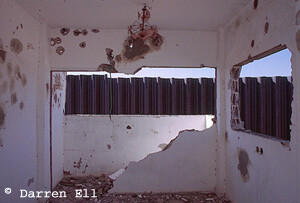
Above: Bullet-scarred walls in a Rafah home.
I first traveled to Gaza with a Canadian international worker after photographing in Jenin. During my first evening there, I met a Palestinian journalist who suggested I travel to Rafah to witness the travail of the people living along the Egyptian border. Upon arrival the next morning, people began pulling me into their homes in Block O. I entered one home through a large hole in the wall to find a mother feeding her 5 young children. The hole had been created to allow for quick escape in case the IDF attacks became too intense. In the neighboring home, whose southern wall had been completely removed, I stood with the occupants watching the armored bulldozer pass by. Beyond the bulldozer was the 6-meter high metal fence the Israelis are constructing along the Egyptian border, a sinister engineering achievement. Beside me, the family’s grandmother wept as, once again, being Palestinian meant losing her home. I held her hand and comforted her, an inadequate gesture for an elderly person about to live on the street in a tent for an indefinite length of time. Children beckoned me on over 10-foot high mounds of rubble mixed with furniture and clothing to see the expanse of sand where 300 Palestinian homes once stood. Israeli tanks flanked the bulldozers and massive cranes were sinking new sections of the wall deep into the earth.
I traveled next to Rafah’s main cemetery where a funeral was being held for Hamed ala-Masri, a 2-year-old boy killed by an IDF bullet the day before. Hamed died while his family was escaping their home during heavy Israeli shelling in the crowded Block J section of Rafah. I asked permission to photograph the funeral. After taking a photograph of Asa’ad Hassan, the grieving father, an elderly man walked past me and said something in an angry tone. I asked my driver what he had said, afraid I had offended the family. “No no!” he said. “He told you to tell the world what the Israelis have done.” This wasn’t the last time I would hear such pleas for help from the outside world. After the funeral, I visited and photographed the child’s mother, Asmaa’, in Rafah’s hospital, where she was recovering from critical injuries to the abdomen sustained during the attack. I promised her family I would tell her story back in Canada. Thus concluded my first day in Rafah.
Several days later, I returned to Rafah with New York journalist Kristen Ess and a group of ISM activists. Although I worked independently of ISM, we ended up sharing the next 5 days together living in homes slated for demolition by the IDF. I spent my first evening with Kamal Abu Shammalah and his family, but in their new home far from Block O. Kamal had recently left Block O after his daughter had been killed during a horrific IDF attack one month earlier. According to Kamal and Palestinian human rights organizations, the IDF was shelling houses in the crowded area, perhaps as cover for the bulldozers which had begun the construction of the wall the day before. 6 civilians were killed and 40 others wounded. Continuing Israeli gunfire and shelling obstructed access to ambulances and medical personnel. Kamal’s daughter was killed by shrapnel to the head as the family was fleeing to their brother’s home. I spent the evening talking with Kamal and enjoying the company of his wife and 5 surviving children. Since the incident, Kamal’s wife has difficulty sleeping or eating, and the children are constantly asking where their sister has gone. A friend of mine had witnessed this massacre and immediately called Canadian mainstream journalists in Jerusalem to report the story. They never even returned his call.
The following day, I began photographing homes soon to be demolished in Block O. Within little time, the occupants of one of the homes invited me to stay with them. The same generosity was extended to two ISM volunteers in the area. For the next 4 days I became acquainted not only with a wonderful family, but with what Palestinians call “the background music,” that is, the constant machine gun fire and explosions that rock their communities. Their house, which the father Mousa had built, is riddled with bullet holes and surrounded by empty expanses of sand where houses once stood. Israeli bulldozers have pushed the sand up against his house. Mousa had placed bricks in the dining room window to protect his family from the daily tank rounds. On our third day there, a 2-hour gun battle raged 75 meters from the house between the IDF and Palestinian fighters. Later that day, as we were eating the Ramadan breakfast, two large rounds slammed into the wall of the house and a third entered through the bathroom window and struck the kitchen wall. Any one of us could have been killed.
That night, IDF flares lit up the sky and spy drones circled the refugee camp. I thought of Mousa, working his entire career on an Israeli kibbutz only to have the IDF destroy his home with no offer of compensation. I thought too of his daughter, Safa, who when I asked her why they didn’t move, said simply, “This is our land. Why should we move?”
Darren Ell in an independent photographer living in Montreal, Canada.
Related Links



